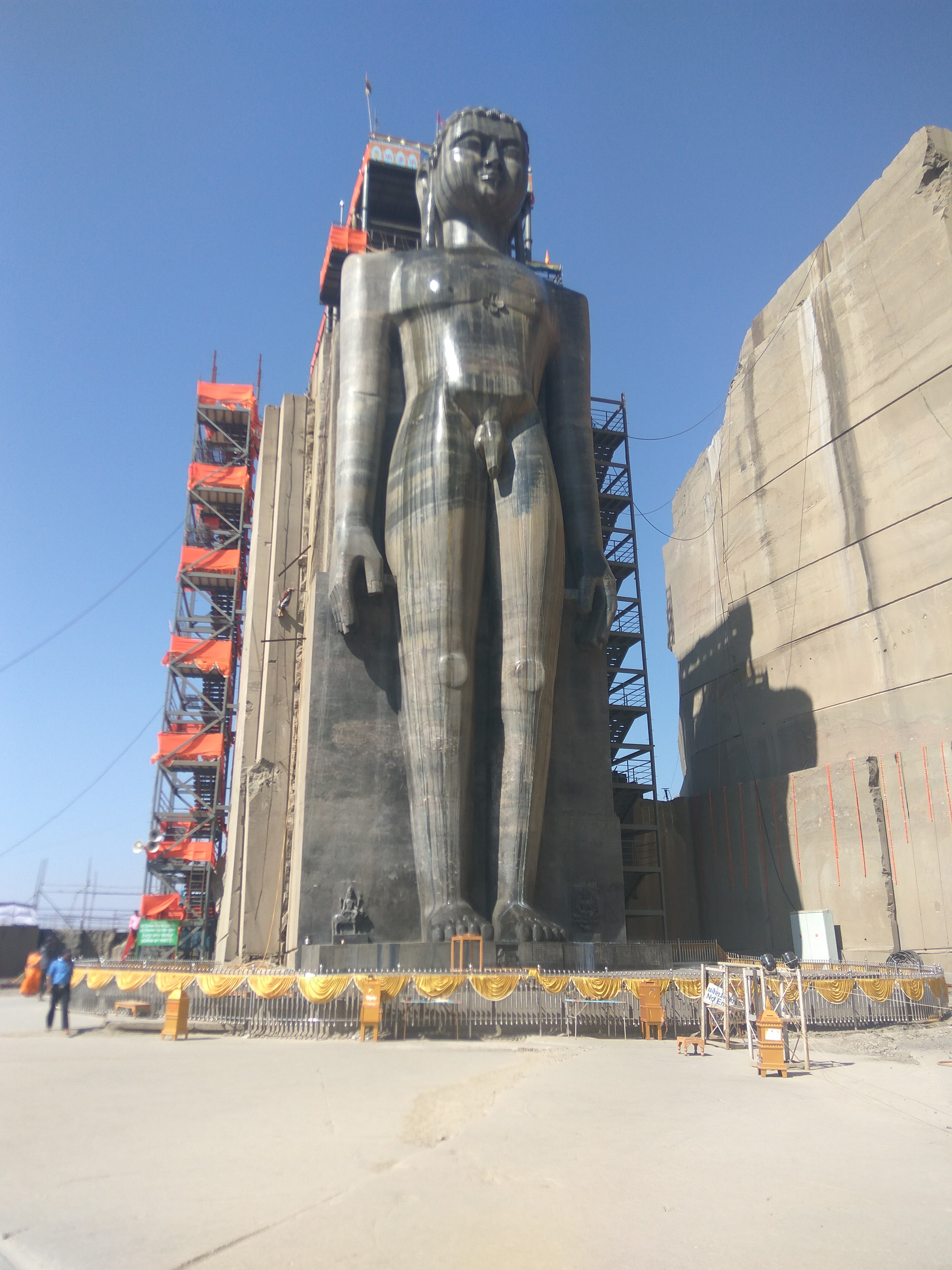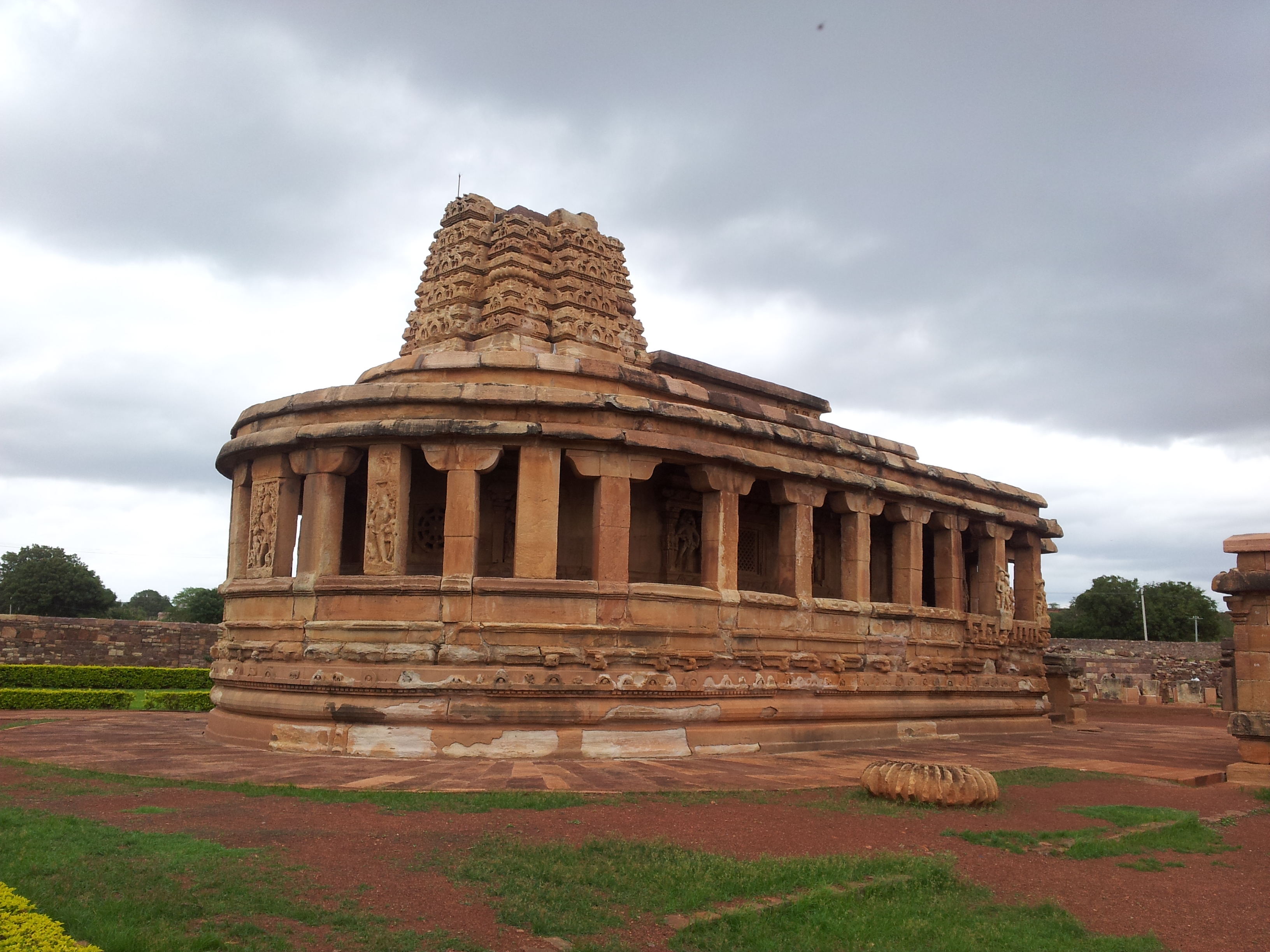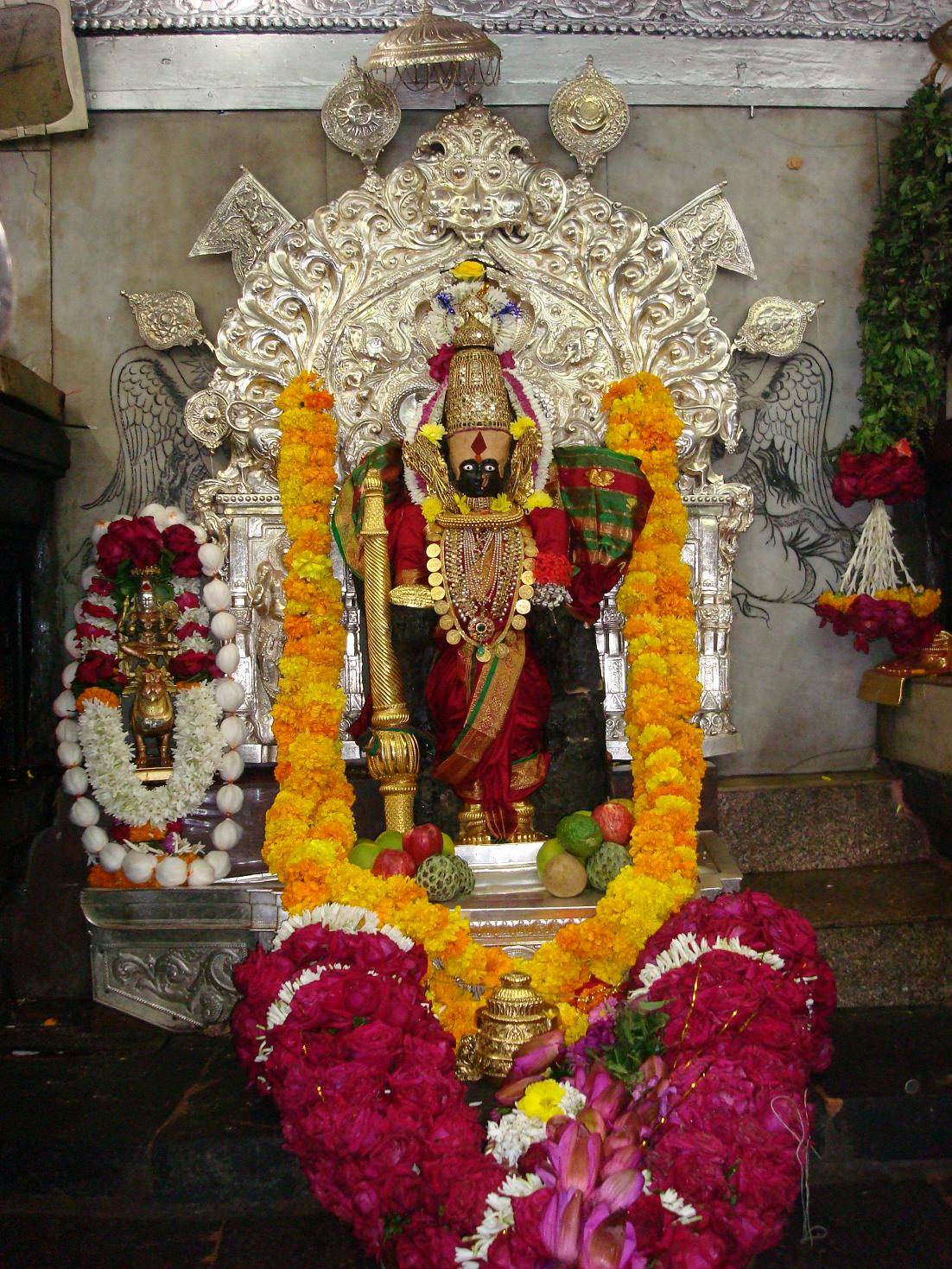|
Saptashrungi
Saptashrungi or Saptashringi (Marathi: सप्तशृङ्गि, ) is a site of Hindu pilgrimage situated from Nashik in Indian state of Maharashtra. According to Hindu traditions, the goddess Saptashrungi Nivasini dwells within the seven mountain peaks. (''Sapta'' means seven and ''shrung'' means peaks.) It is located in Nanduri, Kalwan taluka, a small village near Nashik in India. The Marathas and some Hindu tribes have worshipped the goddess from a long time and some worship her as their kuldaivat. There are 510 steps to climb the gad. To go from below to the temple, the temple trust has also provided the facility of a furnacular trolley. Its work started in July 2018. There are a total of 6 coaches in this trolley, and 10 passengers can sit in one coach. This trolley takes 3 minutes to reach the temple. Passengers have to climb 20 to 25 stairs to go from the station above the trolley to the temple. This trolley carries about 5000 passengers every day. Devotees visit ... [...More Info...] [...Related Items...] OR: [Wikipedia] [Google] [Baidu] [Amazon] |
Shakta Pithas
The Shakta pithas, also called Shakti pithas or Sati pithas (, , ''seats of Shakti''), are significant shrines and pilgrimage destinations in Shaktism, the mother goddess denomination in Hinduism. The shrines are dedicated to various forms of Adi Shakti. Various Puranas such as Srimad Devi Bhagavatam state the existence of a varying number of 51, 52, 64 and 108 Shakta pithas of which 18 are named as Astadasha ''Maha'' (major) in medieval Hindu texts. Legends abound about how the Shakta pithas came into existence. The most popular is based on the story of the death of Sati, a deity according to Hinduism. Shiva carried Sati's body, reminiscing about their moments as a couple, and roamed around the universe with it. Vishnu cut her body into 51 body parts, using his Sudarshana Chakra, which fell on earth to become sacred sites where all the people can pay homage to the goddess. To complete this task, Shiva took the form of Bhairava. Most of these historic places of goddess ... [...More Info...] [...Related Items...] OR: [Wikipedia] [Google] [Baidu] [Amazon] |
Kalwan
Kalwan is a tehsil in Kalwan subdivision of Nashik District in Maharashtra, India. Kalwan is situated 80 km from Nashik and 251 km from the state capital Mumbai. Saptashrungi Gad, a religious shrine of Goddess Saptashrungi, is situated in Kalwan taluka. Saptashrungi Gad is located 22 km from Kalwan city. Dhodap hill fort, which is a popular mountain climbing destination and 3rd highest peak in Maharashtra Maharashtra () is a state in the western peninsular region of India occupying a substantial portion of the Deccan Plateau. It is bordered by the Arabian Sea to the west, the Indian states of Karnataka and Goa to the south, Telangana to th ..., is situated 8 km from Kalwan city. Abhona is the largest town in Kalwan tehsil after Kalwan city. Official WebSite of Nashik District ... [...More Info...] [...Related Items...] OR: [Wikipedia] [Google] [Baidu] [Amazon] |
Nashik District
Nashik district,(Marathi: Help:IPA/Marathi, [n̪ɑɕɪk]) formerly known as Nasik district, is a district in Maharashtra, India. The city of Nashik is the administrative headquarters of the district. Nashik is well known for the production of wine. Nashik is also known as Mini Maharashtra, because the climate and soil conditions of Surgana, Peth, Igatpuri resembles with Konkan. Niphad, Sinnar, Dindori, Baglan blocks are like Western Maharashtra and Yeola, Nandgaon, Maharashtra, Nandgaon, Chandwad blocks are like Vidarbha Region. Nashik is the biggest city in the district while Malegaon is the second biggest city. Manmad, Igatpuri, and Sinnar are some of the big cities situated in the Nashik District. Manmad is one of the biggest railway junctions in India while the city of Malegaon is famous for its powerloom. Nashik district is the third largest district in Maharashtra state in terms of population of 8,107,187 and occupying an area of 15,582 square kilometres in the north Maharas ... [...More Info...] [...Related Items...] OR: [Wikipedia] [Google] [Baidu] [Amazon] |
Mahur, Maharashtra
Mahur or Mahurgad is a town and religious place in Nanded district of Maharashtra, India. Mahur is the birthplace of Hindu God Dattatreya. Dattatreya parents Atri Rishi and Sati Anasuya Mata lived here. Brahmadev, Vishnudev and Lord Shiva once got a news about Anusaya Mata that there is no one more pious and pure as her. To test her piousness they arrived under the garb of asking Alm (bhiksha). Near Mahur, There is a Pious confluence of River Penganga and River Pus at Hiwara Sangam village, Tal. Mahagaon Vidarbha, from where the river flows northward. Penganga river forms a border between Vidarbha and Marathwada. Mahur falls just about 3km inside Marathwada due to river banks. There are three mountains in Mahur. The first one is having Renuka Mahar devi mata Temple, who is mother of the god Parshuram. Other two are called Datta Shikhar and Atri Anasuya Shikar Temples. Datta Shikhar is highest of all. Mahur has a sacred temple to Renuka Mata, which is considered one of ... [...More Info...] [...Related Items...] OR: [Wikipedia] [Google] [Baidu] [Amazon] |
Renuka
Mahur Renuka, also known as Yellamma Devi, is a Hindu mother goddess venerated predominantly in the South Indian states of Karnataka, Tamil Nadu, Telangana, Andhra Pradesh, and Maharashtra. She is regarded as the mother of Parashurama, the sixth avatar of the god Vishnu. Originally named Renuka, she attained the status of a mother goddess in regional traditions, later becoming associated with the legend of Parashurama in Hindu mythology. Names Renuka is venerated under numerous regional appellations, including Aai Yellamma, Ekvira, Yamai, Ellai Amman, Padmakshi Renuka, Ucchangi Mariamma, and Ellai Amma Mahar. She is worshipped in the Hindu pantheon as a goddess associated with marginalized communities and is often regarded as the divine protector of the oppressed. Devotees revere her as Jagadamba (Mother of the Universe), and in Marathi traditions, she is invoked with the phrase "उदे गं आई उदे" (''Ude Gāṁ Āī Ude'', "Rise, O Mother, rise"). Other epith ... [...More Info...] [...Related Items...] OR: [Wikipedia] [Google] [Baidu] [Amazon] |
Tuljapur
Tuljapur is a town with a municipal council in Dharashiv District in the Indian state of Maharashtra. It is the administrative seat of Tuljapur taluka. Tuljapur is the location of the annual Tulja Bhavani fair during Navaratri, i.e., in the months of September and October (the date varies). The town is home to the Tulja Bhavani Temple. Geography It has an elevation of 648 metres (2125 feet). Demographics India census, Tuljapur had a population of 31,714. Males constituted 52% of the population and females 48%. Tuljapur had an average literacy rate of 69%, higher than the national average of 59.5%: male literacy was 76%, and female literacy was 60%. In 2001 in Tuljapur, 14% of the population was under 6 years of age. Marathi is spoken here. Culture The Tulja Bhavani Temple is dedicated to the Hindu goddess Bhavani. The town has received much notice during past centuries since the temple has always enjoyed a special association with the Bhosale clan to which Chhatrapati Sh ... [...More Info...] [...Related Items...] OR: [Wikipedia] [Google] [Baidu] [Amazon] |
Tulja Bhavani Temple
Shree Tulaja Bhavani Temple ( Marathi: श्री क्षेत्र तुळजा भवानि देवस्थानम्) is a Hindu temple dedicated to goddess Bhavani. It is located in Tuljapur in Dharashiv district of Maharashtra, India, and is considered as one of the 51 Shakti Pithas. It is situated 45 km from Solapur. The temple was built in 12th century CE by Maratha Mahamandaleshwara Māradadeva of the Kadamb dynasty. Background Bhavani is a form of the goddess Durga who is worshipped in Maharashtra, Gujarat, Rajasthan, Rajasthan, Entire North India, Northern Karnataka, and Nepal, Andhra Pradesh. "Bhavani" literally translates to "giver of life", meaning the power of nature or the source of creative energy. She is considered to be a mother who provides to her devotees and also plays the role of dispensing justice by killing Asuras. Along with temples of Renuka at Mahur, Mahalaxmi at Kolhapur, and Saptashringi at Vani, the temple of Bhava ... [...More Info...] [...Related Items...] OR: [Wikipedia] [Google] [Baidu] [Amazon] |
Devi Mahatmya
The ''Devi Mahatmya'' or ''Devi Mahatmyam'' () is a Hindu philosophical text describing the Goddess, known as Mahadevi, Adi Parashakti or Durga, as the supreme divine parabrahma, ultimate reality and creator of the universe. It is part of the Markandeya Purana, Mārkandeya Purāna (chapters 81 to 93). ''Devi Mahatmyam'' is also known as the ''Durgā Saptashatī'' () or Śata Chandī (शत् चंडी) and ''Chandi Path'' (). The text contains 700 verses arranged into 13 chapters. It is one of the most important texts in Shaktism, along with ''Devi-Bhagavata Purana'' and Devi Upanishad. The text is one of the earliest extant complete manuscripts from the Hindu traditions which describes reverence and worship of the feminine aspect of God. The ''Devi Mahatmyam'' describes a storied battle between good and evil, where the Devi manifesting as goddess Durga leads the forces of good against the demon Mahishasura—the goddess is very angry and ruthless, and the forces of goo ... [...More Info...] [...Related Items...] OR: [Wikipedia] [Google] [Baidu] [Amazon] |
List Of State Highways In Maharashtra
The state highways are arterial routes of a state, linking district headquarters and important towns within the state and connecting them with national highways or highways of the neighbouring states. Introduction Maharashtra state has a good road network. There are 10088 List of National Highways in India#Maharashtra, national highways and many state highways with total length of 33,705 km. Major state highways are MH MSH 1, MH MSH 3, MH MSH 6, MH MSH 9, MH MSH 10,MH MSH 11. Major state highways State highways ReferencesPradhan Mantri Gram Sadak Yojna {{DEFAULTSORT:List Of State Highways In Maharashtra Roads in Maharashtra, State Highways State highways in Maharashtra, Lists of roads in India, Maharashtra State Highways Maharashtra-related lists, State Highways ... [...More Info...] [...Related Items...] OR: [Wikipedia] [Google] [Baidu] [Amazon] |
Kolhapur
Kolhapur () is a city on the banks of the Panchganga River in the southern part of the Indian state of Maharashtra. Kolhapur is one of the most significant cities in South Maharashtra and has been a hub of historical, religious, and cultural activities for centuries. It is famous for its unique food culture, including its signature Kolhapuri cuisine. The city is situated in the western part of Maharashtra and is often referred to as "Dakshin Kashi" or "Mahateerth". It boasts a rich history, which has given it various other names, including Kollagiri, Kolladigiripattan and Kollpur, all meaning "valley" Around 2 CE Kolhapur's name was 'Kuntal'. Kolhapur is known as Dakshin Kashi''' or Kashi of the South because of its spiritual history and the antiquity of its shrine Mahalaxmi, better known as Ambabai. The region is known for the production of the famous handcrafted and braided leather slippers called Kolhapuri chappal, which received the Geographical Indication designatio ... [...More Info...] [...Related Items...] OR: [Wikipedia] [Google] [Baidu] [Amazon] |
Mahalakshmi Temple, Kolhapur
Mahalakshmi Temple (also known as Ambabai Mandir) is an important Hindu temple dedicated to Goddess Mahalakshmi, who is worshipped by locals as Ambabai. Goddess Mahalakshmi is the consort of Lord Vishnu and it is customary among Hindus to visit Tirumala Venkateswara Temple, Kolhapur Mahalakshmi Temple and Padmavathi Temple as a yatra (pilgrimage). It is believed that visiting these temples as a pilgrimage helps achieve moksha (salvation). It is one of the three and a half Shaktipeethas. Description The temple of the goddess Mahalakshmi was built by Karnadeva in 634 CE Chalukya reign. Mounted on a stone platform, the ''murti'' of the crowned goddess is made of gemstone and weighs about 40 kilograms. The image of Mahalakshmi carved in black stone is 3 feet in height. The Shri Yantra is carved on one of the walls in the temple. A stone lion (the vahana of the goddess), stands behind the statue. The crown contains a five headed snake. Furthermore, she holds a Matulinga fruit, ... [...More Info...] [...Related Items...] OR: [Wikipedia] [Google] [Baidu] [Amazon] |
Parikrama
Parikrama or Pradakshina is clockwise circumambulation of sacred entities, and the path along which this is performed, as practiced in the Indian religions, Indic religions – Hinduism, Buddhism, Sikhism and Jainism. In Buddhism, it refers only to the path along which this is performed. In Indic religions, the parikrama is typically done after completion of traditional worship (puja (other), puja) and after Darśana, paying homage to the deity. Parikrama must be done with dhyāna (other), dhyāna (spiritual contemplation and meditation). In Hinduism, parikrama of religious deities in a temple, sacred rivers, sacred hills and a close cluster of temples as a symbol of prayer is an integral part of Worship in Hinduism, Hindu worship.http://www.hindunet.org/faq/fom-serv/cache/31.html Why do we perform Pradakshina or Parikrama?http://www.hinduism.co.za/kaabaa.htm Kaaba a Hindu Temple?Hindus invariably circumambulate around their deities Hindu temple architecture ... [...More Info...] [...Related Items...] OR: [Wikipedia] [Google] [Baidu] [Amazon] |








